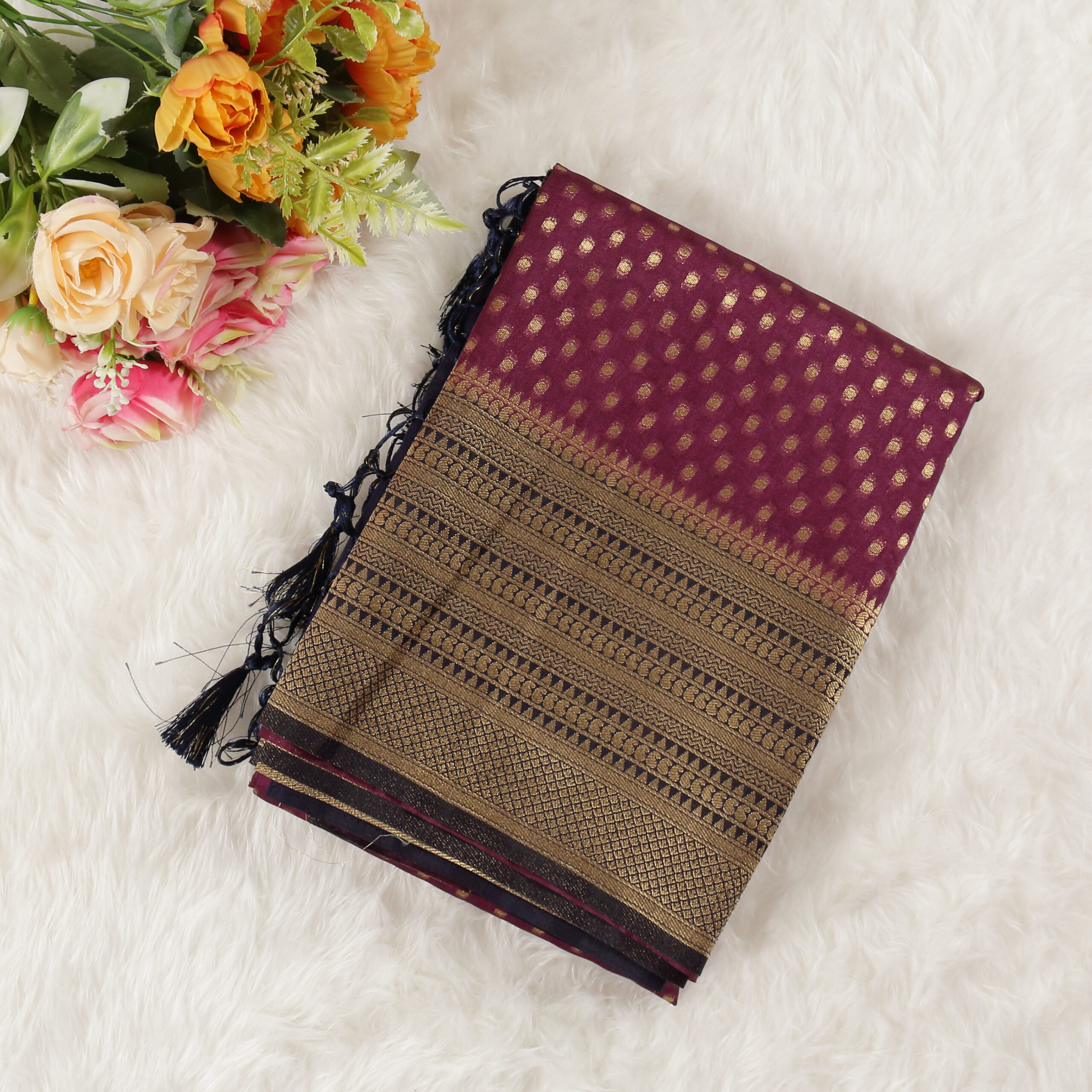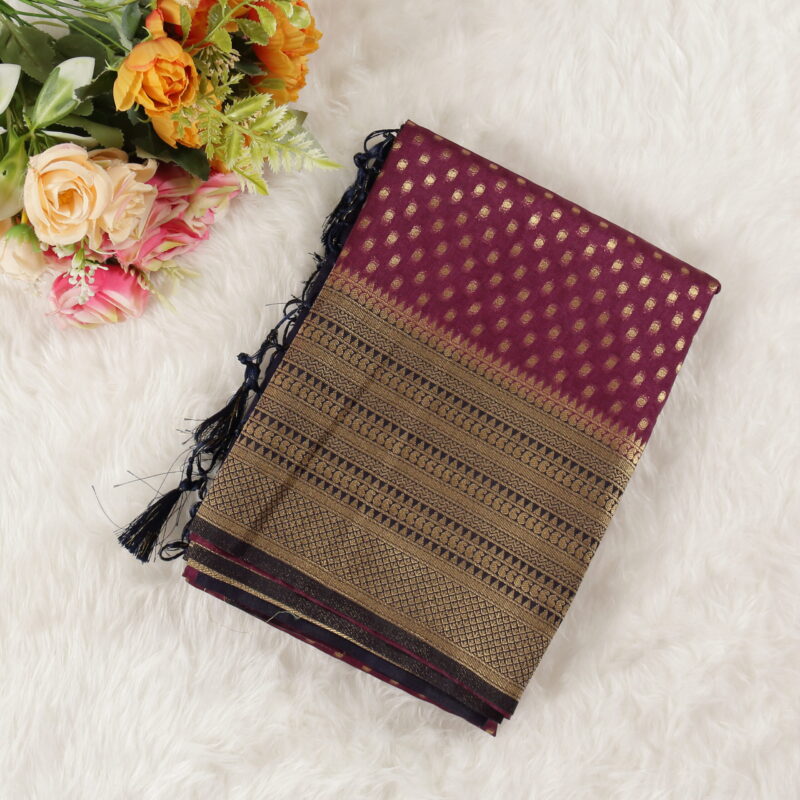The Beautiful Banarasi Silk Sarees

Beautiful Banarasi Silk Saree
India’s center of weaving has been considered Banaras, a religiously significant place, since the beginning of time. The Rig Veda and the Mahabharata are two religious texts that make reference to artwork made of banarasi silk. The earliest known form of Kimkhab brocades, called Hiranya, were described in the Rig Veda as a strange gold cloth worn by the gods themselves. They were woven with genuine gold and silver zari in a silken core. Putambar Vastra or Hiranya Vastra were the names given to these textiles in the Ramayana and Mahabharata. The Jataka Tales and the Vedas both contained information about weaving processes. Kashi (Banaras) has been described as a well-known textile center even in Pali literature.
https://sapienstyle.com/product/banarasi-georgette-saree-blue-kv0001/The Banarasi handloom, which was originally designed for royalty, has a rich history that is evident in its weaves. Banarasi Silk Sarees are well known for its brilliant designs and patterns, exquisite craftsmanship, and unwavering durability. While some historians claim that Rajasthani art and Hindu motifs had a major effect on the early brocades, it has been noted that these early designs ended after the 16th century. History contains references indicating that weavers from Gujarat came to Banaras during the 14th and 16th century floods, fires, and famines. It is also thought that around this period silk was first used for brocades in the Banarasi weaving business.
The art of creating brocades with elaborate designs and patterns out of fine gold and silver zari threads emerged in the 14th century during the Mughal era. The Persians, Mughals, and Central Asians had a great influence on the Banarasi silk handlooms that are sold nowadays. A Banarasi masterpiece’s long history of painstaking handcrafting is still a classic that will be discussed for decades to come. The silken artworks’ patterns, designs, and themes, however, are what draw the attention in. Let’s take a closer look at the construction and characteristics of Banarasi Silk Sarees.
Banarasi silk sarees contents
Opulence of Banarasi Silk Sarees
The Weave’s Abundance rich weaving skills used to create Banarasi sarees have been passed down through the ages. These sarees, which are made of silk and adorned with zari work in gold and silver, are proof of the unmatched skill of Banaras weavers.
Intricate Design of Banarasi Silk Sarees
These saris are distinguished by their intricately woven floral and foliate motifs, kalga and bel, and a row of erect leaves known as jhallar at the outer edge of the border.
Luxurious Fabric of Banarasi Silk Sarees
A Banarasi sari is one that is crafted in Varanasi, the historic city also known as Benares (Banaras). These are some of the best saris in India, and they’re prized for their exquisite silk, lavish embroidery, and gold and silver brocade, or zari.

The Method Used to Weave Banarasi Silk Sarees
- A Banarasi silk saree can be woven in anywhere from three to thirty days, depending on how intricate the desired motifs and patterns are. Typically, a saree like this requires the cooperation of three weavers.
- The silk saree is woven by the first weaver, the revolving ring is managed by the second weaver to create bundles, and the final weaver assists with border design.
- Years of expertise are necessary to possess the exceptional collaboration and workmanship needed to create a Banarasi saree.
- An ideal Banarasi saree should have about 5600 threads, each 45 inches broad. These skilled artisans produce a base that is between 24 and 26 inches long.
- The process of designing the motifs begins with the bundling step. At this stage, an artist uses graph paper to draw the designs and color schemes in order to create design boards.
- Following this, hundreds of perforated cards that can suit a single saree pattern are made before punch cards are finalized. The perforated cards are knitted on the loom using a variety of colors and threads.
- After that, the perforated cards are paddled one after the other until the primary weave picks up the appropriate colors and patterns. This is the process of creating a remarkable, authentic Banarasi saree.
- Banarasi Silk Sarees are woven using a variety of techniques, such as Tanchoi, Kadhwa, Cutwork, Kadhiyal, and Meenakari.
Features of Banarasi Sarees That Are Finely Crafted
When it comes to patterns and motifs, Banarasi Silk Sarees feature Mughal-era floral designs and jaals. Aside from this, Banarasi heirlooms are renowned for their elaborate Shikargah decorations. Shikargah is more than just a single theme; rather, it is a beautiful collection of patterns that portray hunting scenes with a variety of woodland creatures as well as a human figure hunting. The Jaal design, which surrounds a booti with a web of geometric or curved patterns, is another superb example.
Patterns with Mughal influences, such the floral and leafy motifs known as kalga and bel, and the outside border designs of upright leaves called Jhallar, have developed into traditional Banarasi motifs that are frequently created to enhance the weave’s beauty and grandeur.
Stunning Banarasi Silk Sarees
With any luck, this post offered you a taste of Banarasi Silk Sarees‘ illustrious past. You will always look stunning in these timeless sarees for any important occasion. We have every banarasi silk silhouette you could possibly need, whether you’re searching for a bridal banarasi saree or a classic-contemporary banarasi saree to wear at a lavish cocktail party.

